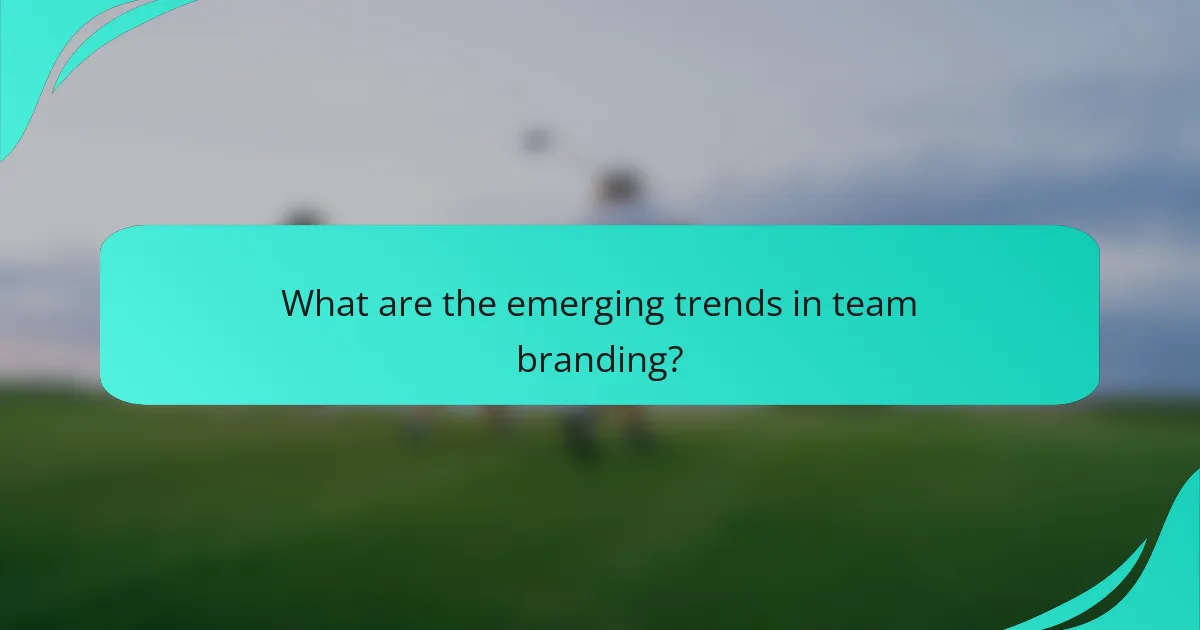Team branding plays a crucial role in fostering fan loyalty and engagement by establishing a strong identity that resonates emotionally with supporters. By creating a recognizable brand through consistent visual elements and engaging narratives, teams can cultivate a sense of belonging and pride among fans, ultimately encouraging long-term commitment and interaction.

How does team branding influence fan loyalty?
Team branding significantly impacts fan loyalty by creating a strong identity that resonates emotionally with supporters. A well-defined brand fosters a sense of belonging and pride, encouraging fans to remain committed and engaged over time.
Emotional connection to the brand
Fans often develop deep emotional ties to their team’s brand, which can stem from shared experiences, community values, and memorable moments. This connection can manifest through rituals, such as wearing team colors or attending games, reinforcing loyalty.
For example, a team that actively engages with its community through local events or charity initiatives can strengthen this emotional bond, making fans feel like they are part of something larger than just a sports team.
Increased fan retention rates
Effective team branding can lead to higher fan retention rates, as loyal supporters are more likely to continue purchasing tickets, merchandise, and subscriptions. Teams with strong brands often see retention rates that exceed industry averages, as fans feel a personal investment in the team’s success.
To maintain these rates, teams should consistently communicate their brand values and engage with fans through social media, newsletters, and community outreach programs.
Enhanced community engagement
Strong team branding enhances community engagement by fostering a sense of pride and identity among local supporters. When teams actively participate in community events or support local causes, they create a positive image that resonates with fans.
For instance, organizing youth sports clinics or sponsoring local events can deepen ties with the community, encouraging fans to rally around the team and participate in its success.

What strategies enhance team branding?
Effective team branding strategies focus on creating a strong, recognizable identity that resonates with fans. By implementing consistent visual elements, engaging narratives, and a robust social media presence, teams can significantly boost fan loyalty and engagement.
Consistent visual identity
A consistent visual identity includes logos, color schemes, and typography that reflect the team’s character and values. This visual coherence helps fans easily recognize the team across various platforms, from merchandise to social media. For example, teams like FC Barcelona utilize their iconic colors and crest to foster a strong brand image.
When developing a visual identity, ensure that all materials, including jerseys, promotional items, and digital content, align with the established design. This uniformity creates a sense of belonging among fans and enhances brand recall.
Engaging storytelling
Engaging storytelling involves sharing narratives that connect fans emotionally to the team. This can include player backgrounds, historical moments, and community involvement stories. For instance, the New York Yankees often highlight their storied past and legendary players to deepen fan connections.
To effectively tell these stories, utilize various formats such as videos, articles, and podcasts. Consistently sharing compelling content can keep fans invested and encourage them to share their experiences, further amplifying the team’s brand.
Active social media presence
An active social media presence allows teams to interact directly with fans, fostering a sense of community. Regular updates, behind-the-scenes content, and fan engagement initiatives can significantly enhance loyalty. Teams like the Los Angeles Lakers leverage platforms like Instagram and Twitter to keep fans informed and entertained.
To maximize engagement, create a content calendar that includes game highlights, player interactions, and fan polls. Additionally, responding to fan comments and messages can strengthen relationships and encourage ongoing support.

How can teams measure branding impact on engagement?
Teams can measure the impact of branding on fan engagement through various methods that provide insights into fan perceptions and behaviors. Key approaches include gathering direct feedback, analyzing social media interactions, and tracking merchandise sales.
Fan surveys and feedback
Conducting fan surveys is a direct way to gauge branding impact on engagement. Surveys can include questions about brand perception, loyalty, and emotional connection to the team. Aim for a response rate of at least 10-15% to ensure meaningful data.
Consider using platforms like SurveyMonkey or Google Forms to distribute surveys easily. Incentivizing participation with discounts or exclusive content can also enhance response rates.
Social media analytics
Social media analytics provide valuable insights into fan engagement levels and brand sentiment. Tools like Hootsuite or Sprout Social can track metrics such as likes, shares, comments, and overall reach. Monitoring these metrics over time helps identify trends in fan engagement.
Focus on engagement rates rather than just follower counts, as higher engagement indicates a stronger connection with the brand. Regularly assess which types of content resonate most with fans to refine your branding strategy.
Merchandise sales tracking
Tracking merchandise sales is a practical method to measure branding impact, as increased sales often correlate with stronger fan engagement. Analyze sales data to identify which products are popular and how they relate to branding campaigns.
Consider implementing point-of-sale systems that can track sales trends over time. Look for seasonal spikes or changes in purchasing behavior following branding initiatives, as these can provide insights into the effectiveness of your branding efforts.

What role does local culture play in team branding?
Local culture significantly influences team branding by shaping the identity and values that resonate with fans. A strong connection to community traditions and sentiments can enhance fan loyalty and engagement, making the team a source of local pride.
Reflecting community values
Team branding should align with the core values of the community it represents. This can include promoting inclusivity, resilience, or teamwork, which are often seen as vital traits in local culture. For example, a team in a region known for its strong work ethic might emphasize hard work and dedication in its branding efforts.
Engaging with local leaders and organizations can help teams identify these values. Surveys or community forums can provide insights into what fans cherish most, allowing teams to tailor their messaging and initiatives accordingly.
Incorporating local traditions
Incorporating local traditions into team branding can create a deeper emotional connection with fans. This might involve celebrating local festivals, using regional symbols, or integrating traditional music and art into game-day experiences. For instance, a team could host events that coincide with local holidays or collaborate with local artists to design merchandise.
Teams should also consider how local sports history can influence their branding. Acknowledging past achievements or legendary local figures can foster a sense of pride and continuity among fans. This approach not only honors the community’s heritage but also strengthens the team’s identity within that context.

How can teams leverage partnerships for branding?
Teams can enhance their branding by forming strategic partnerships that resonate with their fan base and community. These collaborations not only boost visibility but also foster deeper connections with fans, ultimately driving loyalty and engagement.
Collaborations with local businesses
Partnering with local businesses allows teams to create a strong community presence. These collaborations can include joint promotions, co-branded merchandise, or hosting events that engage fans. For example, a team might work with a local brewery to offer special game-day drinks, which can attract fans to both the team and the business.
Local partnerships can also help teams tap into the unique culture of their area, making their branding more relatable. Consider offering discounts to fans who shop at partner businesses, which can encourage loyalty to both the team and the local economy.
Sponsorship deals with major brands
Sponsorship deals with major brands provide teams with significant financial support while enhancing their visibility. These partnerships often involve logo placements, advertising during games, and promotional campaigns that can reach a wider audience. Teams should seek brands that align with their values and resonate with their fan demographics for maximum impact.
When negotiating sponsorships, teams should consider the terms carefully, ensuring that the partnership enhances their brand rather than dilutes it. For instance, a sports team might partner with a well-known athletic apparel brand to create exclusive merchandise, which can drive both revenue and fan engagement.

What are the emerging trends in team branding?
Emerging trends in team branding focus on enhancing fan engagement and loyalty through innovative strategies. Teams are increasingly leveraging technology and unique experiences to create deeper connections with their supporters.
Use of augmented reality experiences
Augmented reality (AR) experiences are becoming a pivotal aspect of team branding, allowing fans to interact with their favorite teams in immersive ways. By integrating AR into mobile apps or during live events, teams can offer unique content, such as virtual player interactions or enhanced game statistics.
For example, a team might provide an AR feature that allows fans to view player stats in real-time by pointing their device at the field. This not only enriches the viewing experience but also encourages fans to engage more actively with the team’s brand.
When implementing AR, teams should consider the technology’s accessibility and ease of use. Ensuring that experiences are compatible with a wide range of devices can maximize participation and enhance overall fan satisfaction.
